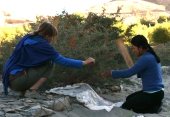The county septic inspectors will not say one way or another whether it is safe to garden over.
The field itself (if it's anything like the ones we have here) requires grass to work properly. The moisture is absorbed through the grass and perspires through the leaves - This is over simplifying the process, it's far more complex than that. Perhaps someone with more experience could chime in?
Here, when we have long periods of drought, planting trees or anything with roots near the sceptic field or tank would be the worst idea imaginable. Especially hardy trees like mulberries or willows with huge roots. They would seek out the moisture in the dry months. Even if we kept the trees pruned, it would still create liability for the next owners of the property who may not be aware of septic maintenance and let the trees grow - roots grow - roots grow into septic field - may get us in future legal trouble for planting the trees too close.
Then again, when we arrived, there are all sorts of trees bordering the septic field. Neighbours have a big line of tall conifers along 4 meters away on one side, and an ancient apple tree, probably planted in the 1860s or 1870s (that's ancient for here) two meters away on the other side. The field use to flood every summer before we moved here, but like I mentioned we get drought. The field has been replaced once before we got here, but it made no difference to the flooding. When we moved here we did two things (none of which involved getting rid of trees). First we had the tank pumped - first time since the early 1960s that it had been pumped. It was solid, about fifty/fifty earthworms and earth - sadly we aren't allowed to keep the soil

. The second thing was to put sheep on the pasture. They improved the health of the grass in about two years. Now the grass is only dead for 2 months of the year instead of 6. Those two months are also when the well is just about empty, so we don't use much water then anyway.
There are a lot of fancy tricks and tips to use for sceptic health - everything from buying the correct toilet paper and cleaning products (according to the guy with the honey truck, certain shampoos really bugger up the system) to having the right sort of lawn (or in my case, mixed pasture grasses). And then different systems work differently and different parts of the world have different systems... it can get confusing. Some of the writers here may have systems that don't rely on grass like mine do. In that case, having garden on top may work just fine.
It's a good thing you are thinking about it. I've met many people in our area who don't even know they have a septic field until they smell the stink of a broken one. We could do with some more public education here - congratulations, you bought a house with a septic field, here's what you need to know.
As for trees - my opinion is that it depends a lot on your weather patterns. With lots of drought, it's more likely to be a problem then somewhere with reasonable rainfall year round. Also, it may be to your advantage to know the local regulations regarding septic systems. Some places have laws against planting xyz, such and such a distance from the system.













 4
4












 . The second thing was to put sheep on the pasture. They improved the health of the grass in about two years. Now the grass is only dead for 2 months of the year instead of 6. Those two months are also when the well is just about empty, so we don't use much water then anyway.
. The second thing was to put sheep on the pasture. They improved the health of the grass in about two years. Now the grass is only dead for 2 months of the year instead of 6. Those two months are also when the well is just about empty, so we don't use much water then anyway.





























